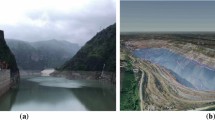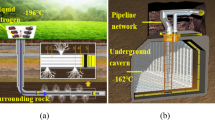Abstract
Water content has a pronounced influence on the properties of rock materials, which is responsible for many rock engineering hazards, such as landslides and karst collapse. Meanwhile, water injection is also used for the prevention of some engineering disasters like rock-bursts. To comprehensively investigate the effect of water content on mechanical properties of rocks, laboratory tests were carried out on sandstone specimens with different water contents in both saturation and drying processes. The Nuclear Magnetic Resonance technique was applied to study the water distribution in specimens with variation of water contents. The servo-controlled rock mechanics testing machine and Split Hopkinson Pressure Bar technique were used to conduct both compressive and tensile tests on sandstone specimens with different water contents. From the laboratory tests, reductions of the compressive and tensile strength of sandstone under static and dynamic states in different saturation processes were observed. In the drying process, all of the saturated specimens could basically regain their mechanical properties and recover its strength as in the dry state. However, for partially saturated specimens in the saturation and drying processes, the tensile strength of specimens with the same water content was different, which could be related to different water distributions in specimens.

















Similar content being viewed by others
Abbreviations
- NMR:
-
Nuclear magnetic resonance
- RF:
-
Radio frequency
- UCS:
-
Uni-axial compressive strength
- XRD:
-
X-ray diffraction
- MTS:
-
Material test system
- LVDT:
-
Linear variant differential transducer
- SHPB:
-
Split Hopkinson pressure bar
- ISRM:
-
International Society for Rock Mechanics
- \(\omega_{\text{w}}\) :
-
Water content of the specimen (%)
- \(m_{\text{w}}\) :
-
Wet mass of the specimen (g)
- \(m_{\text{d}}\) :
-
Dry mass of the specimen (g)
- \(\sigma_{\text{t}}\) :
-
Tensile strength of the specimen (MPa)
- P m :
-
Maximum value of loading force (kN)
- D :
-
Diameter of the specimen (mm)
- L s :
-
Length of the specimen (mm)
- \(\sigma_{\text{c}}\) :
-
Compressive strength of the specimen (MPa)
- \(\varepsilon_{\text{f}}\) :
-
Failure strain of the specimen under uni-axial compression (%)
- \(E\) :
-
Elastic modulus of the specimen (GPa)
- \(R^{2}\) :
-
Coefficient of correlation
- P 1 :
-
Force between the specimen and input bar (kN)
- P 2 :
-
Force between the specimen and output bar (kN)
- \(\varepsilon_{\text{I}}\) :
-
Signal on the incident bar
- \(\varepsilon_{\text{R}}\) :
-
Signal on the reflected bar
- \(\varepsilon_{\text{T}}\) :
-
Signal on the transmitted bar
- \(A_{\text{e}}\) :
-
Cross sectional area of elastic bars (mm2)
- \(A_{\text{s}}\) :
-
Cross sectional area of the specimen (mm2)
- \(C_{\text{e}}\) :
-
Wave propagation velocity in the specimen (km/s)
- \(E_{\text{e}}\) :
-
Young’s modulus of elastic bars (GPa)
References
Bai H, Ma D, Chen Z (2013) Mechanical behavior of groundwater seepage in karst collapse pillars. Eng Geol 164:101–106
Bieniawski ZT, Hawkes I (1978) Suggested methods for determining tensile strength of rock materials. Int J Rock Mech Min Sci Geomech Abstr 15:99–103
Broch E (1974) The influence of water on some rock properties. Proceeding of the 3rd Congress of the International Society for Rock Mechanics, pp 33–38
Buxton RB (2009) Introduction to functional magnetic resonance imaging: principles and techniques. Cambridge University Press, Cambridge
Colback P, Wild B (1965) The influence of moisture content on the compressive strength of rocks. Proceeding of the 3rd Canadian Symposium on Rock Mechanics, pp 55–83
Dai F, Xia K (2010) Loading rate dependence of tensile strength anisotropy of Barre granite. Pure appl Geophys 167(11):1419–1432
Dai F, Huang S, Xia K, Tan Z (2010) Some fundamental issues in dynamic compression and tension tests of rocks using split Hopkinson pressure bar. Rock Mech Rock Eng 43(6):657–666
Edelman RR, Warach S (1993) Magnetic resonance imaging. N Engl J Med 328(10):708–716
Eeckhout EMV, Peng SS (1975) The effect of humidity on the compliances of coal mine shales. Int J Rock Mech Min Sci Geomech Abstr 12(11):335–340
Hawkins AB, Mcconnell BJ (1992) Sensitivity of sandstone strength and deformability to changes in moisture content. Eng Geol 25(2):115–130
Huang S, Xia K, Yan F, Feng X (2010) An experimental study of the rate dependence of tensile strength softening of Longyou sandstone. Rock Mech Rock Eng 43(6):677–683
Iverson RM (2000) Landslide triggering by rain infiltration. Water Resour Res 36(7):1897–1910
Lu T, Zhao Z, Hu H (2011) Improving the gate road development rate and reducing outburst occurrences using the waterjet technique in high gas content outburst-prone soft coal seam. Int J Rock Mech Min Sci 48(8):1271–1282
McConnell BJ (1989) Factors controlling sandstone strength and deformability in uniaxial compression. University of Bristol
Rossi P (1991) A physical phenomenon which can explain the mechanical behaviour of concrete under high strain rates. Mater Struct 24(6):422–424
Song D, Wang E, Liu Z, Liu X, Shen R (2014) Numerical simulation of rock-burst relief and prevention by water-jet cutting. Int J Rock Mech Min Sci 70:318–331
Van Eeckhout EM (1976) Mechanisms of strength reduction due to moisture in coal mine shales. Int J Rock Mech Min Sci Geomech Abstr 13(2):61–67
Vásárhelyi B (2005) Statistical analysis of the influence of water content on the strength of the Miocene limestone. Rock Mech Rock Eng 38(1):69–76
Vásárhelyi B, Ván P (2006) Influence of water content on the strength of rock. Eng Geol 84(s 1–2):70–74
Zhang QB, Zhao J (2014) A review of dynamic experimental techniques and mechanical behaviour of rock materials. Rock Mech Rock Eng 47(4):1411–1478
Zhou YX, Zhao J (2011) Advances in rock dynamics and applications. CRC Taylor & Francis press, Boca Raton
Zhou Z, Li X, Ye Z, Liu K (2010) Obtaining constitutive relationship for rate-dependent rock in SHPB tests. Rock Mech Rock Eng 43(6):697–706
Zhou J, Chen X, Wu L, Kan X (2011a) Influence of free water content on the compressive mechanical behaviour of cement mortar under high strain rate. Sadhana 36(3):357–369
Zhou Z, Li X, Liu A, Zou Y (2011b) Stress uniformity of split hopkinson pressure bar under half-sine wave loads. Int J Rock Mech Min Sci 48(4):697–701
Zhou YX, Xia K, Li XB, Li HB, Ma GW, Zhao J, Dai F (2012) Suggested methods for determining the dynamic strength parameters and mode-I fracture toughness of rock materials. Int J Rock Mech Min Sci 49:105–112
Acknowledgments
The authors acknowledge the financial support from both the National Natural Science Foundation of China (51322403, 51274254) and National Basic Research Program of China (2015CB060200).
Author information
Authors and Affiliations
Corresponding author
Rights and permissions
About this article
Cite this article
Zhou, Z., Cai, X., Cao, W. et al. Influence of Water Content on Mechanical Properties of Rock in Both Saturation and Drying Processes. Rock Mech Rock Eng 49, 3009–3025 (2016). https://doi.org/10.1007/s00603-016-0987-z
Received:
Accepted:
Published:
Issue Date:
DOI: https://doi.org/10.1007/s00603-016-0987-z




